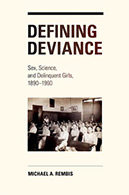Defining Deviance: Sex, Science, and Delinquent Girls, 1890-1960
 Author: Michael A. Rembis
Author: Michael A. Rembis
Champaign, IL: University of Illinois Press. 2011. 237p.
Reviewer: Russ Immarigeon | May 2012
Histories of various aspects of “crime and punishment,” from policing through incarceration, are too rare, especially in the United States. But juvenile delinquency seems to have captured the imagination, and empirical efforts, of American historians more than other areas of criminal justice. Juvenile justice historians have been particularly reliant on available data concerning the confinement of boys and girls in state training schools in states such as California, Illinois, Massachusetts, and New York.
Michael A. Rembis, a historian at the University of Buffalo in New York State, notes in this engaging study that American concerns with juvenile delinquency started with World War I and reached “epidemic proportions” during the course and aftermath of World War II. “Hindsight and decades of scholarly research leave little doubt,” he reflects, “ that the domestic upheaval caused by both wars, the nascent civil rights and feminist movements, and a burgeoning youth culture, as well as better record keeping and an ever-expanding juvenile justice and child guidance system, contributed to the rising numbers of so-called juvenile delinquents, but the popular perception among most Americans living between 1917 and 1960 was one of a nation of young people run amok.”
In Defining Deviance, Rembis relies on two sets of data. The first is information on girls who were incarcerated at the State Training School for Girls in Geneva, Illinois. Descriptive information about these girls is used less as a focus of the study than as illustration for a second set of data, which consists of the social reform history and the psychological and psychoanalytic literature that evolved between 1890 and 1960, the timeframe for this study. Defining Deviance, then, is more of an intellectual history of the theoretical and practical understanding of human behavior, juvenile misbehavior and disorderliness in particular, than an empirical assessment, or a review of particular penal practices.
A large majority of the girls at Geneva were white ethnic European immigrant (or second generation) females. Black girls comprised about 10 percent of the Geneva population, Rembis reports, but he does not believe they were “overrepresented.” For Rembis, this volume is more about gender and class. Many of these girls were from industrial and manufacturing sections of Chicago at a time when these economic engines were reshaping the country.
Rembis describes this study as “the story of the ways in which female adolescent ‘sex delinquents’ became entangled in the national rebuilding project, and of their resistance to that project. It spans 70 years and involves a diverse group of social actors. Numerous laypeople weave their way in and out of this narrative, but the main characters are teenage girls ….. and the dizzying array of largely female experts who examined them. This is the story of contestation: contestation between female adolescent ‘sex delinquents’ and the women and men attempting to diagnose and treat them; and between the latter over the best possible, most effective means of diagnosing and treating a vulnerable group of young women and ultimately ‘improving’ society.”
Defining Deviance is an Illinois-based history of the eugenic (and later non-eugenic) segregation of girls charged and convicted of sexual misbehavior and other “status” and “criminal” offenses. It is far from a comprehensive history, but it is compelling nonetheless.
Beyond introductory and wrap-up chapters, six chapters at the core of Defining Deviance focus on the following topics: The role of white middle-class women reformers, and their eventual partnership with male colleagues, in creating a state-sponsored system of eugenic commitment and segregation; how these reformers focused their attention on ethnically white working class adolescents; the shifting landscape between the first and second world wars pertaining to eugenic commitment, mental classifications, and community care; how mental health experts used inmate evaluations “to render the seemingly invisible visible” and how these experts contested these evaluations internally; external factors beyond mental health examinations that affected institutional assessments of delinquent girls; and shifts in social attitudes and scientific theories that by the early 1950s revised perceptions of the causes and treatment of female juvenile delinquency.
Rembis has organized these queries temporally, that is, he begins his investigation in the late 1800s, just before the end of one century and the start of another, and continues through the 1950s. Rembis skillfully describes how earlier theoretical and empirical advances meld into later ones, but he also chronicles the roots of certain advances that took time to bloom, with some of this development shadowed by alternative efforts that had their own life spans.
Rembis concludes this volume with the observation that “sex delinquent” girls (now often called “bad girls”) are still adjudicated, incarcerated, and released in a context characterized by “increasingly complex scientific and medical discourses of disablement.”
“Like all social-scientific endeavors,” Rembis notes, “the transition from a biological theory of delinquency to a personality theory of delinquency was played out in different cultural locations, with multiple variations and distinct levels of exchange.”
In Defining Deviance, Rembis shows “how a continuously interactive process involving scientific and legal experts, institutional administrators, legislators, reformers, concerned citizens, and perhaps, most importantly, delinquent girls and their families shaped the history of the cultural construction of mental ‘deviance’ and juvenile delinquency in the United States.”
Separate appendices reprint Illinois’ Involuntary Commitment Law (1915) and Illinois’ Model Sterilization Law (1916). Other back-of-the-book features include extensive footnotes and a thorough bibliography of selected sources and references. The volume is indexed.
Russ Immarigeon is an editor of Offender Programs Report


